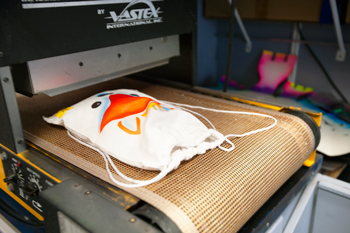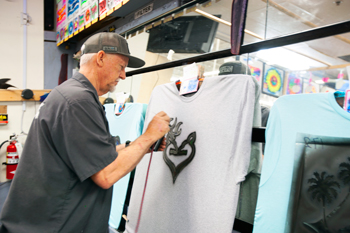PANAMA CITY BEACH, FL — Veteran airbrush artist Mark Rush founded Big Airbrush Inc. in 1985. The business has since grown to six stores in Florida Walmart Supercenters that operate from 8:00 a.m. to 11:00 p.m. 364 days a year. He also runs a successful online storefront and sells merchandise through his website www.bigairbrush.com and Amazon Handmade.
In addition to his thriving business, Rush enjoys fame in the airbrush world. His inventions, including a line of silent airbrush compressors and customized airbrushes, have improved the art of airbrushing and are used by artists worldwide.
Each store employs two to four artists who airbrush approximately 500 shirts per day per store, in addition to merchandise such as truckers' caps, towels, license plates, sand dollars and shoes. A Vastex D-100 infrared conveyor dryer cures approximately five shirts a minute.
"We do a million dollars a year in sales at each store. That's a lot of shirts," says Rush. "We have to be able to dry them as fast as the artist paints them. Some designs take a few minutes to paint; some take longer. But without the infrared dryer, we would never be able to handle the volume that we do."
Infrared conveyor dryer improves quality, dry times
Airbrush artists traditionally cure painted shirts using a heat gun or a heat press. According to Rush, a heat gun can scorch shirts while a heat press accentuates areas of overspray, making them "stick out like a sore thumb."
Furthermore, set-up on a heat press can be time-consuming. To ensure paint doesn't seep through the shirt, the operator has to place a barrier between the front and the back of the shirt. Rush estimates that the heat press takes four times longer than the infrared dryer to cure a shirt.
Rush was first introduced to an infrared dryer in the '70s while working in a screen printing shop in Colorado. After running a couple of shirts through the dryer, he realized that this method would be suitable for drying airbrushed garments as well.
In 1978, Rush moved to Hawaii where he airbrushed surfboards and T-shirts. When he returned to Colorado he worked in another screen printing shop-this time as an airbrush artist. He used the shop's infrared dryer to cure his shirts and was immediately taken with the technology.
In 1984, Rush opened Big Airbrush in Panama City and purchased his first infrared conveyor dryer to dry airbrushed shirts and merchandise. As the business grew he replaced the old dryer with a Vastex D-100 conveyor dryer and bought additional units until he had one in every store.
Belt speeds determine by airbrushed substrates
The dryer is a compact tabletop unit with an 18 in. (46 cm) wide conveyor belt and adjustable heater height, temperature, and belt speed. Rush likes the unit's small footprint because it fits the limited space in his stores.
In addition to drying T-shirts, the dryer cures Rush's other products including towels, license plates, face masks and sneakers. "We run everything through it, except hats," he says. "Those we dry with a heat gun."
The dryer is set on medium-high (approximately 300°F [149°C]) and stays at that temperature day in and day out. Rush claims that he has not burned a shirt in 36 years. The operator adjusts the conveyor belt's speed depending on the material being cured. Face masks, for example, dry faster than T-shirts, so the operator speeds up the conveyor belt. Gauging the correct belt speed is more art than science: The operator watches the shirts and masks as they enter the dryer's tunnel and adjusts the speed accordingly.
"The machine is capable of drying 20 masks a minute, but we can't paint them that fast, so we dry six to eight masks a minute," says Rush.
Big Airbrush also uses the dryer to flash-cure vanity license plates before weatherproofing them with a clear coat of enamel. Finished plates are dry to the touch and hung on a rack to await enamel application, which takes eight to ten hours to fully dry in open air.
Rush has also found a use for the infrared dryer that reduces the need for spray adhesive, which contains solvent.
"We spray adhesive on the back of our stencils to make them stick to the shirts," he explains. "It's environmentally unfriendly, so instead of spraying more adhesive on the stencils, we run them through the dryer, sticky side up, which reheats and reactivates the glue."
The guru of airbrushing
To call Rush a legendary airbrush artist would not be a stretch: In 1982 he graced the cover of the first airbrush magazine to be published. He was the first artist to start using a different airbrush for every color, and he developed the Iwata Great White and Hammerhead Shark line of silent airbrush compressors for which he holds the patent. He also developed a hand-cut stencil system and was first to customize airbrushes with bullet-type tips and ergonomic features for greater comfort.
Rush's interest in airbrushing began as a child when he saw Ed "Big Daddy" Roth airbrush shirts at a fair. Soon he was airbrushing shirts in his parent's garage and selling his designs to kids at school. His first job was airbrushing dresses and jackets in an upscale clothing store.
Today, Rush uses siphon-feed airbrushes for all of Big Airbrush's T-shirt designs. Customers can choose from more than 1,000 stock designs or customize their orders.
His artists use Iwata Eclipse airbrushes for outlining and detail work, and Paasche VL size 3 and 5 airbrushes for broad color work and light, fluorescent colors.
"When you're doing detail work, you need to get close to the shirt and use a small amount of air and paint for super-fine lines," Rush explains. "Then, as you move away from the shirt, you pull back further on the trigger to let out more paint for doing fades. The whole idea is to create texture with the airbrush stroke so that you can make a cloud look fluffy or a palm tree look like it has bark on it."
Artists stretch shirts over Masonite® boards and place them on an easel designed to hold 20 shirts simultaneously. Next, they walk up and down the row of shirts applying one color at a time. Finished garments are run through the conveyor dryer and fall into a bin upon exit.
"Once you pop the shirt in the dryer, you don't have to look at it again until you pull it out of the bin," says Rush. Shirt tags are numbered before they run through the dryer to facilitate sorting and packing orders.
Rush has had his D-100 infrared conveyor dryers for about eight years and has no plans to upgrade them.
"The dryers run 364 days a year, all day long, and the only thing we ever have to replace is the motor," he says. "They seem to be indestructible."
Big Airbrush
850 588-5342
sales@bigairbrush.com
www.bigairbrush.com















